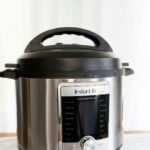Introduction to Food Choppers
Food choppers are essential kitchen tools designed to simplify the food preparation process. They come in various forms, from manual versions to electrically powered models, each designed to efficiently chop, dice, and mince an array of ingredients. The primary components typically include a chopping bowl, blade assembly, and a lid. Some advanced models may incorporate features like multiple blade sizes or additional attachments for specific tasks. This versatility makes the food chopper a favored alternative to larger appliances such as blenders and food processors.
While blenders are primarily recognized for their ability to puree and liquefy ingredients, thereby making smoothies and soups, food choppers serve a more specialized function. They excel at handling solid ingredients, facilitating tasks that require precise size uniformity, such as cutting vegetables for stir-fries or dicing meat for stews. Their focused capacity ensures that the food maintains its texture, an essential aspect when enhancing the overall quality of a dish.
On the other hand, food processors are more versatile but can also be cumbersome and take up valuable kitchen space. Designed for multiple tasks, food processors can slice, shred, knead, and mix, but they often require a more extensive cleanup process. In contrast, a food chopper is generally easier to clean and store, making it a suitable option for those with limited kitchen space or who seek convenience in their cooking process.
With their straightforward design and functionality, food choppers have gained popularity among both home cooks and professional chefs. They provide an efficient solution for quick meal prep, allowing culinary enthusiasts to unleash their culinary potential with ease. Understanding the unique characteristics and advantages of food choppers highlights their importance in modern kitchens and their contribution to cooking efficiency.
Basic Chopping Functions
A food chopper is an invaluable tool in any kitchen, designed to expedite the meal preparation process and enhance efficiency. The primary function of a food chopper revolves around its capability to chop a variety of ingredients, including vegetables, fruits, and herbs, with remarkable speed and uniformity. This device simplifies tasks that are often time-consuming and labor-intensive when done by hand, such as dicing onions, mincing garlic, or slicing bell peppers.
Using a food chopper offers numerous advantages over manual techniques. For instance, it not only saves time but also reduces the physical effort associated with chopping. The ergonomic design of most food choppers minimizes the strain on the user’s hands and wrists, allowing for longer periods of food preparation without discomfort. Moreover, the consistency of cuts achieved with a food chopper can contribute to a uniformly cooked meal, as evenly chopped ingredients tend to cook at the same rate.
When it comes to selecting items for chopping in a food chopper, several types of foods stand out as particularly well-suited. Common vegetables such as carrots, celery, and zucchini are great choices, as are fibrous herbs like parsley, cilantro, and basil, which can be quickly minced for use in recipes. Moreover, fruits such as apples, pears, and even berries can also be processed effectively, making a food chopper a versatile ally in both savory and sweet dishes.
Overall, the fundamental chopping functions of a food chopper streamline meal prep and enhance the cooking experience. With its ability to efficiently handle a variety of ingredients, it serves as an essential kitchen device for home cooks and professional chefs alike.
Slicing and Dicing Made Easy
Food choppers have become essential kitchen tools, excelling in the art of slicing and dicing various ingredients with remarkable efficiency. Equipped with an array of cutting attachments and blades, these appliances enable users to achieve consistent and uniform results when preparing meals. For instance, the inclusion of a sharp slicing blade allows for the precision cutting of meats, ensuring that each piece is evenly sized, which is particularly beneficial for cooking evenly and presenting dishes attractively.
Dicing vegetables can often be a time-consuming task, especially when dealing with onions and peppers, which can be tedious to chop finely by hand. A food chopper simplifies this process, providing users the ability to quickly and skillfully dice these ingredients. To optimize the chopping process, it is advised to cut the items into smaller sections before placing them into the chopper, as this allows for more even and efficient cutting. Additionally, selecting the appropriate blade attachment for the desired size of the dice can dramatically improve results, making meal preparation smoother and more enjoyable.
Practical tips for utilizing a food chopper include ensuring proper cleaning and maintenance of the blades to maintain their sharpness. Storing the appliance in a readily accessible location can encourage its use, ultimately enhancing meal preparation’s overall speed and efficiency. Experimenting with various ingredients and textures can lead to delightful culinary discoveries, allowing home cooks to explore diverse recipes and flavor combinations. As versatility is one of the key advantages of food choppers, integrating them into your daily cooking routine can significantly enhance the quality and ease of meal preparation.
Mincing Garlic, Ginger, and More
Mincing garlic, ginger, and other aromatic ingredients can often be a labor-intensive task when performed by hand. These small yet fragrant elements are essential for enhancing the flavor profiles of various dishes, but their preparation can require considerable effort and time. A food chopper offers an effective solution to this problem, allowing home cooks to achieve the desired consistency with minimal hassle. The advantages of using a food chopper for mincing these ingredients are manifold, particularly in terms of efficiency and uniformity.
One of the primary benefits of utilizing a food chopper for mincing garlic and ginger is the significant reduction in preparation time. With a few easy pulses, you can transform whole cloves of garlic or chunks of ginger into finely minced bits, eliminating the need for tedious knife work. This not only saves time but also energy, allowing chefs to focus on other crucial aspects of meal preparation. Additionally, a food chopper promotes consistency; each piece is cut uniformly, ensuring that flavors are distributed evenly throughout the dish. This level of precision is often difficult to achieve when chopping by hand.
Technique also plays a crucial role in effectively using a food chopper for these aromatic ingredients. When mincing garlic or ginger, it is advisable to first peel the ingredients to remove any outer skin. For herbs like basil or cilantro, a gentle rinsing and drying will enhance chopping efficacy. Furthermore, grouping similar aromatic or herb elements together in the chopper optimizes space and ensures even mincing. Beyond garlic and ginger, this versatile kitchen appliance can also be employed to mince other spices such as shallots or chilies, broadening its utility in enhancing flavor profiles across a range of cuisines.
Making Dressings and Sauces
Food choppers are versatile kitchen tools that can significantly simplify the process of creating dressings and sauces. One of the primary applications of a food chopper in this realm is emulsification, a technique used to combine two liquids that typically do not mix, such as oil and vinegar. To achieve a stable emulsion, begin by adding your vinegar or any acidic component to the food chopper. Gradually introduce oil while the chopper is running, allowing the ingredients to blend seamlessly. The result is a creamy salad dressing that can be tailored with seasonings to meet individual tastes.
In addition to traditional dressings, food choppers prove invaluable when crafting fruit-based dressings. For instance, combining fresh fruits like berries or citrus with a drizzle of honey or maple syrup creates vibrant and flavorful dressings perfect for salads. Simply chop the fruits in the food chopper until they reach a desired consistency, and then mix in the additional ingredients. This method not only enhances the flavor profile of your salads but also introduces natural sweetness and bright colors to your dishes.
Moreover, food choppers facilitate the preparation of sauces. Cooked ingredients, herbs, and spices can be easily blended to achieve a smooth and consistent texture. For sauces requiring a robust flavor, such as pestos or barbecue sauces, utilizing a food chopper allows for efficient chopping of garlic, herbs, and nuts. Once the ingredients are finely chopped, they can be combined with liquids for a cohesive sauce. This capability not only saves time but also ensures that all flavors are evenly distributed throughout, resulting in a sauce that enhances your culinary creations.
Preparing Soups and Stews
A food chopper can significantly streamline the process of preparing soups and stews, making it an indispensable tool in the modern kitchen. The versatility of a food chopper allows users to efficiently chop, dice, and even mince a variety of vegetables, which are often essential components of hearty soups and flavorful stews. By utilizing a food chopper, one can easily process large quantities of ingredients in a fraction of the time it would take to do so manually by hand. This is particularly beneficial for individuals planning to make larger batches of soup or stew, as it allows for quick and consistent results.
For meal prep enthusiasts, a food chopper facilitates advanced ingredient preparation, enabling the chopping of onions, carrots, celery, and garlic, among other vegetables, well ahead of time. By investing a little time in chopping ingredients on a weekend, busy cooks can enjoy the convenience of having prepped vegetables ready to go when weeknight cooking presents itself. This forward-thinking approach not only saves time but also helps maintain a flavorful base for soups and stews, as freshly chopped ingredients release their aromas and flavors more effectively than pre-packaged alternatives.
Moreover, the use of a food chopper contributes to consistent cooking results. Uniformly chopped vegetables ensure even cooking, allowing each ingredient to reach its ideal tenderness at the same time. This quality is vital in achieving that perfect, comforting bowl of soup or stew, where every bite carries the harmonious blend of flavors intended by the cook. In conclusion, incorporating a food chopper into your meal prep routine can elevate your culinary experience, particularly when preparing delightful soups and stews, making the process both efficient and enjoyable.
Creating Smoothies and Dips
Food choppers are versatile kitchen appliances that can greatly simplify the preparation of smoothies and dips, making them excellent allies for health-conscious individuals. With their ability to efficiently process a variety of ingredients, food choppers provide a quick way to whip up flavorful and nutritious blends. Whether it’s a creamy guacamole, a savory hummus, or a zesty salsa, utilizing a food chopper can significantly enhance the texture and consistency of these dishes.
To achieve optimal results when creating smoothies and dips, it is essential to layer your ingredients strategically within the food chopper. Start by placing softer ingredients at the bottom, such as ripe avocados for guacamole or cooked chickpeas for hummus. These softer substances generate the necessary moisture and make it easier for the food chopper to blend the other ingredients effectively. Following these, add your more solid components like vegetables, fruits, or spices to create the desired flavor profile.
When preparing smoothies, a common technique involves combining fruits such as bananas, berries, and yogurt with a splash of liquid, either milk or juice, to facilitate blending. Pulse the food chopper in short bursts, allowing you to monitor the consistency of the smoothie. This technique ensures that all ingredients are evenly blended without overworking the machine.
For dips like salsa, consider chopping fresh herbs and spices separately before integrating them with tomatoes, onions, or peppers. This method enhances the freshness and prevents the herbs from being over-processed. Ultimately, by mastering the layering technique and understanding the various processing capabilities of food choppers, you can create delectable smoothies and dips with ease, making them perfect for both everyday snacks and entertaining guests.
Baking and Pastry Applications
The culinary world is rich with creative possibilities, and a food chopper can be an invaluable tool in the realm of baking and pastry making. Though often synonymous with food preparation tasks such as chopping vegetables and herbs, food choppers can enhance the process of creating delicious baked goods in numerous ways. One significant application is the chopping of nuts, which is essential for various baked items like brownies, muffins, and topping selections for cakes. By utilizing a food chopper, bakers can achieve a uniform texture, resulting in a delightful crunch that enhances both flavor and mouthfeel.
Another unconventional yet effective application for a food chopper is in preparing cookie crusts for desserts such as cheesecake. By crumbling cookies into fine pieces, bakers can create an evenly distributed base that provides a sturdy foundation. This method is not only time-efficient but also allows for a consistent size of the crumbs, leading to a well-formed crust that bakes evenly. Additionally, blending ingredients such as flour and butter into a pastry dough is another task perfectly suited for a food chopper. This technique ensures that the butter is evenly dispersed within the flour, resulting in a tender, flaky pastry that is essential for items like tarts and croissants.
When handling different types of dough, it is crucial to adjust the usage of the food chopper accordingly. For softer doughs, a gentle mix is advisable, while firmer doughs can withstand a more vigorous chopping approach. It is also important to monitor the consistency closely to achieve the desired texture without over-processing the ingredients. By integrating a food chopper into baking practices, the potential for creativity and efficiency is vastly increased, leading to delightful pastries and desserts that express one’s culinary skills.
Conclusion: The Versatile Kitchen Companion
In conclusion, the food chopper emerges as an indispensable tool in the kitchen, showcasing its versatility across a wide array of culinary tasks. This handy device streamlines food preparation, making it an invaluable addition for both novice cooks and seasoned chefs. The range of applications for a food chopper is extensive; it can proficiently handle vegetables, herbs, nuts, and even fruits, easily transforming these ingredients into precise cuts, which can significantly enhance the presentation and flavor of dishes.
Not only does a food chopper save time, but it also promotes consistency in the size and shape of food, which is particularly beneficial when it comes to cooking evenly. By utilizing this kitchen companion, individuals can minimize their workload, tackling common tasks like dicing onions or mincing garlic in a fraction of the time it would take using traditional methods. Consequently, home cooks are provided with more opportunities to explore their creativity in the kitchen, leading to more diverse meal options.
Moreover, the ease of operation associated with food choppers makes them an excellent choice for beginners who may feel overwhelmed by the prospect of chopping by hand. The incorporation of this tool not only builds confidence in one’s cooking abilities but also encourages experimentation with new recipes. For more experienced cooks, a food chopper can serve as a reliable assistant in preparing meals, allowing for a more efficient cooking process.
Ultimately, the food chopper’s ability to simplify food preparation showcases its role as a versatile kitchen companion. By making cooking more accessible and enjoyable, it helps unleash the culinary potential in anyone willing to step into the kitchen.


